University Case Study: Change in Bookbarn’s Operations Analysis
VerifiedAdded on 2023/01/16
|18
|3765
|21
Case Study
AI Summary
This case study analyzes the operational challenges faced by Bookbarn, an Australian office stationary supplier, and the need for transformation within its business processes. It identifies key problems such as inefficient administrative structures, manual ordering systems, outdated resources, lack of IT officials, and resistance to change. The analysis explores the application of Russel Ackoff’s framework for problem-solving, differentiating between hard and soft system problems, and defining key stakeholders. It also evaluates various models, tools, and techniques, including UML, flowchart techniques, DFD, and RAD, to facilitate the transition from manual to computerized systems. The study underscores the importance of addressing stakeholder concerns, especially regarding the impact of IT introduction on employees. The case provides insights into business transformation, problem-solving, and the effective implementation of new technologies in a business environment.
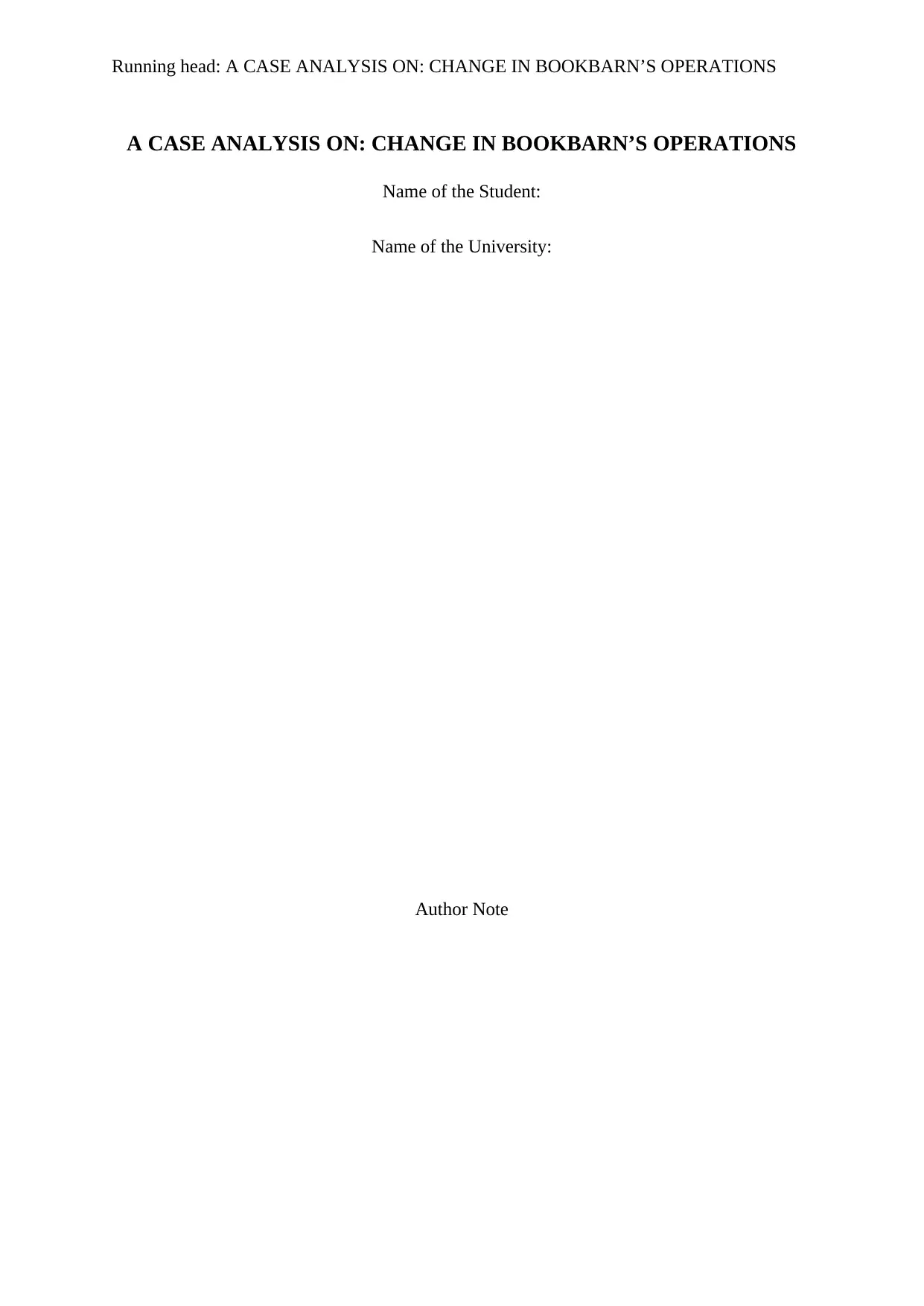
Running head: A CASE ANALYSIS ON: CHANGE IN BOOKBARN’S OPERATIONS
A CASE ANALYSIS ON: CHANGE IN BOOKBARN’S OPERATIONS
Name of the Student:
Name of the University:
Author Note
A CASE ANALYSIS ON: CHANGE IN BOOKBARN’S OPERATIONS
Name of the Student:
Name of the University:
Author Note
Paraphrase This Document
Need a fresh take? Get an instant paraphrase of this document with our AI Paraphraser
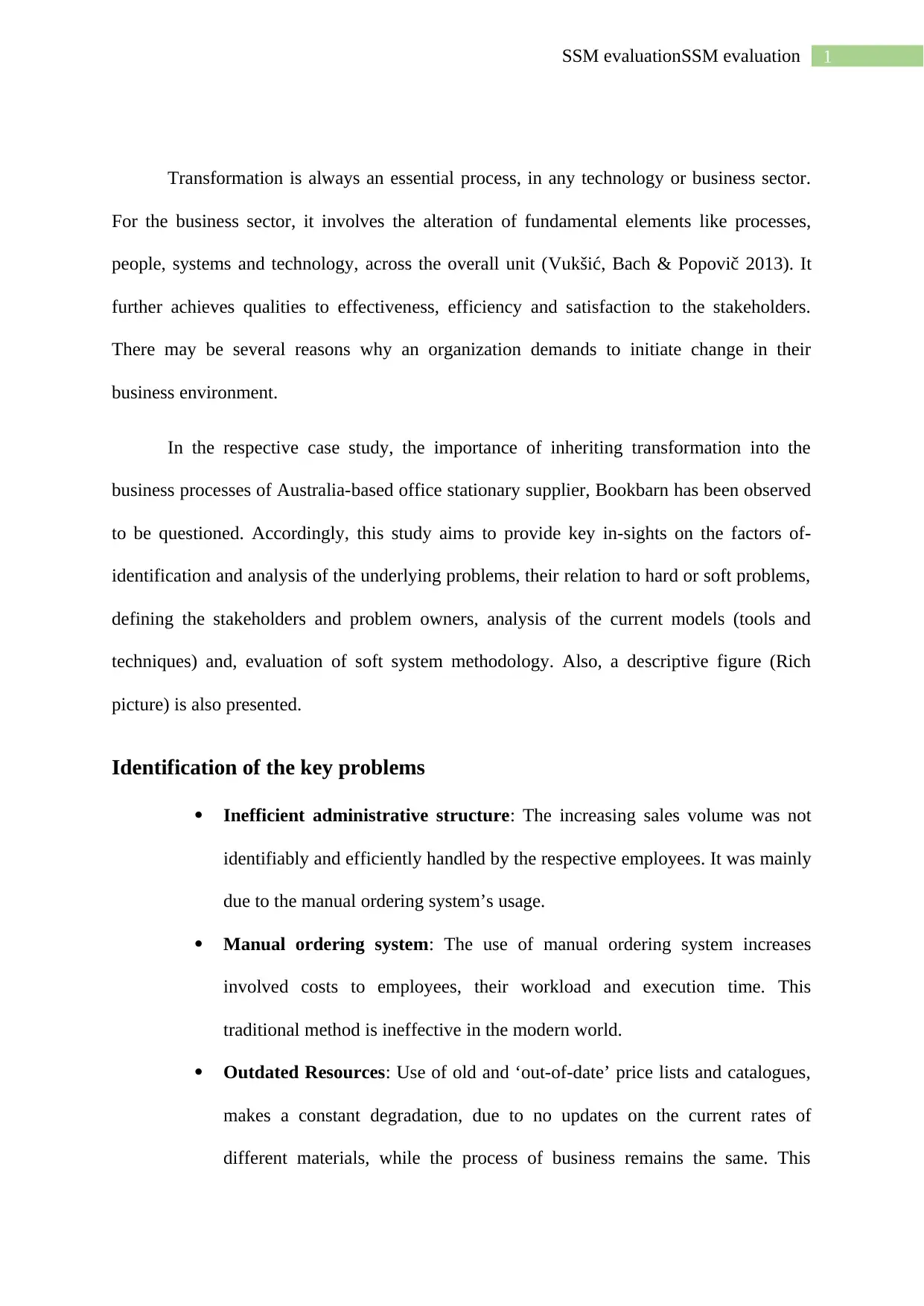
1SSM evaluationSSM evaluation
Transformation is always an essential process, in any technology or business sector.
For the business sector, it involves the alteration of fundamental elements like processes,
people, systems and technology, across the overall unit (Vukšić, Bach & Popovič 2013). It
further achieves qualities to effectiveness, efficiency and satisfaction to the stakeholders.
There may be several reasons why an organization demands to initiate change in their
business environment.
In the respective case study, the importance of inheriting transformation into the
business processes of Australia-based office stationary supplier, Bookbarn has been observed
to be questioned. Accordingly, this study aims to provide key in-sights on the factors of-
identification and analysis of the underlying problems, their relation to hard or soft problems,
defining the stakeholders and problem owners, analysis of the current models (tools and
techniques) and, evaluation of soft system methodology. Also, a descriptive figure (Rich
picture) is also presented.
Identification of the key problems
Inefficient administrative structure: The increasing sales volume was not
identifiably and efficiently handled by the respective employees. It was mainly
due to the manual ordering system’s usage.
Manual ordering system: The use of manual ordering system increases
involved costs to employees, their workload and execution time. This
traditional method is ineffective in the modern world.
Outdated Resources: Use of old and ‘out-of-date’ price lists and catalogues,
makes a constant degradation, due to no updates on the current rates of
different materials, while the process of business remains the same. This
Transformation is always an essential process, in any technology or business sector.
For the business sector, it involves the alteration of fundamental elements like processes,
people, systems and technology, across the overall unit (Vukšić, Bach & Popovič 2013). It
further achieves qualities to effectiveness, efficiency and satisfaction to the stakeholders.
There may be several reasons why an organization demands to initiate change in their
business environment.
In the respective case study, the importance of inheriting transformation into the
business processes of Australia-based office stationary supplier, Bookbarn has been observed
to be questioned. Accordingly, this study aims to provide key in-sights on the factors of-
identification and analysis of the underlying problems, their relation to hard or soft problems,
defining the stakeholders and problem owners, analysis of the current models (tools and
techniques) and, evaluation of soft system methodology. Also, a descriptive figure (Rich
picture) is also presented.
Identification of the key problems
Inefficient administrative structure: The increasing sales volume was not
identifiably and efficiently handled by the respective employees. It was mainly
due to the manual ordering system’s usage.
Manual ordering system: The use of manual ordering system increases
involved costs to employees, their workload and execution time. This
traditional method is ineffective in the modern world.
Outdated Resources: Use of old and ‘out-of-date’ price lists and catalogues,
makes a constant degradation, due to no updates on the current rates of
different materials, while the process of business remains the same. This
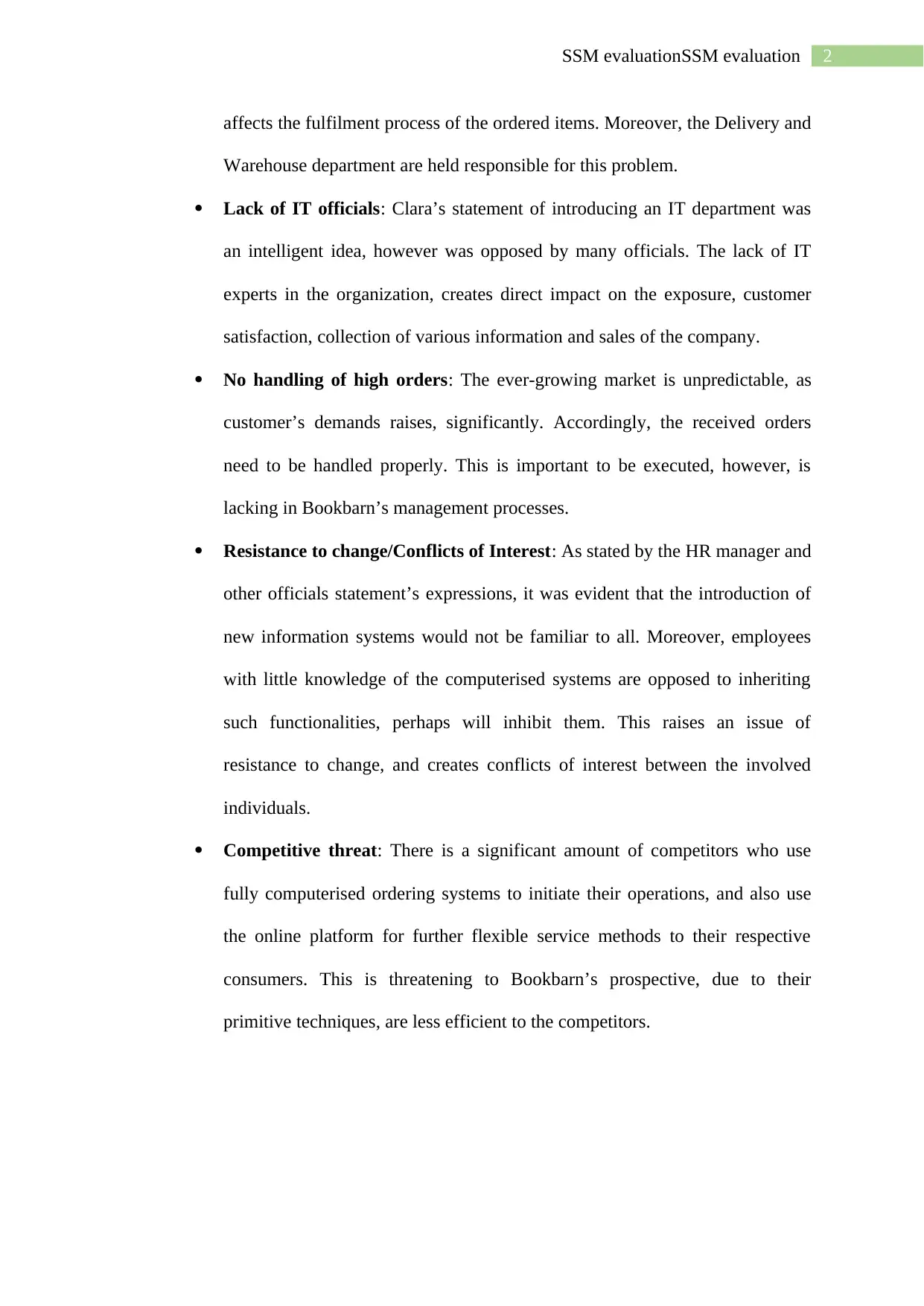
2SSM evaluationSSM evaluation
affects the fulfilment process of the ordered items. Moreover, the Delivery and
Warehouse department are held responsible for this problem.
Lack of IT officials: Clara’s statement of introducing an IT department was
an intelligent idea, however was opposed by many officials. The lack of IT
experts in the organization, creates direct impact on the exposure, customer
satisfaction, collection of various information and sales of the company.
No handling of high orders: The ever-growing market is unpredictable, as
customer’s demands raises, significantly. Accordingly, the received orders
need to be handled properly. This is important to be executed, however, is
lacking in Bookbarn’s management processes.
Resistance to change/Conflicts of Interest: As stated by the HR manager and
other officials statement’s expressions, it was evident that the introduction of
new information systems would not be familiar to all. Moreover, employees
with little knowledge of the computerised systems are opposed to inheriting
such functionalities, perhaps will inhibit them. This raises an issue of
resistance to change, and creates conflicts of interest between the involved
individuals.
Competitive threat: There is a significant amount of competitors who use
fully computerised ordering systems to initiate their operations, and also use
the online platform for further flexible service methods to their respective
consumers. This is threatening to Bookbarn’s prospective, due to their
primitive techniques, are less efficient to the competitors.
affects the fulfilment process of the ordered items. Moreover, the Delivery and
Warehouse department are held responsible for this problem.
Lack of IT officials: Clara’s statement of introducing an IT department was
an intelligent idea, however was opposed by many officials. The lack of IT
experts in the organization, creates direct impact on the exposure, customer
satisfaction, collection of various information and sales of the company.
No handling of high orders: The ever-growing market is unpredictable, as
customer’s demands raises, significantly. Accordingly, the received orders
need to be handled properly. This is important to be executed, however, is
lacking in Bookbarn’s management processes.
Resistance to change/Conflicts of Interest: As stated by the HR manager and
other officials statement’s expressions, it was evident that the introduction of
new information systems would not be familiar to all. Moreover, employees
with little knowledge of the computerised systems are opposed to inheriting
such functionalities, perhaps will inhibit them. This raises an issue of
resistance to change, and creates conflicts of interest between the involved
individuals.
Competitive threat: There is a significant amount of competitors who use
fully computerised ordering systems to initiate their operations, and also use
the online platform for further flexible service methods to their respective
consumers. This is threatening to Bookbarn’s prospective, due to their
primitive techniques, are less efficient to the competitors.
⊘ This is a preview!⊘
Do you want full access?
Subscribe today to unlock all pages.

Trusted by 1+ million students worldwide
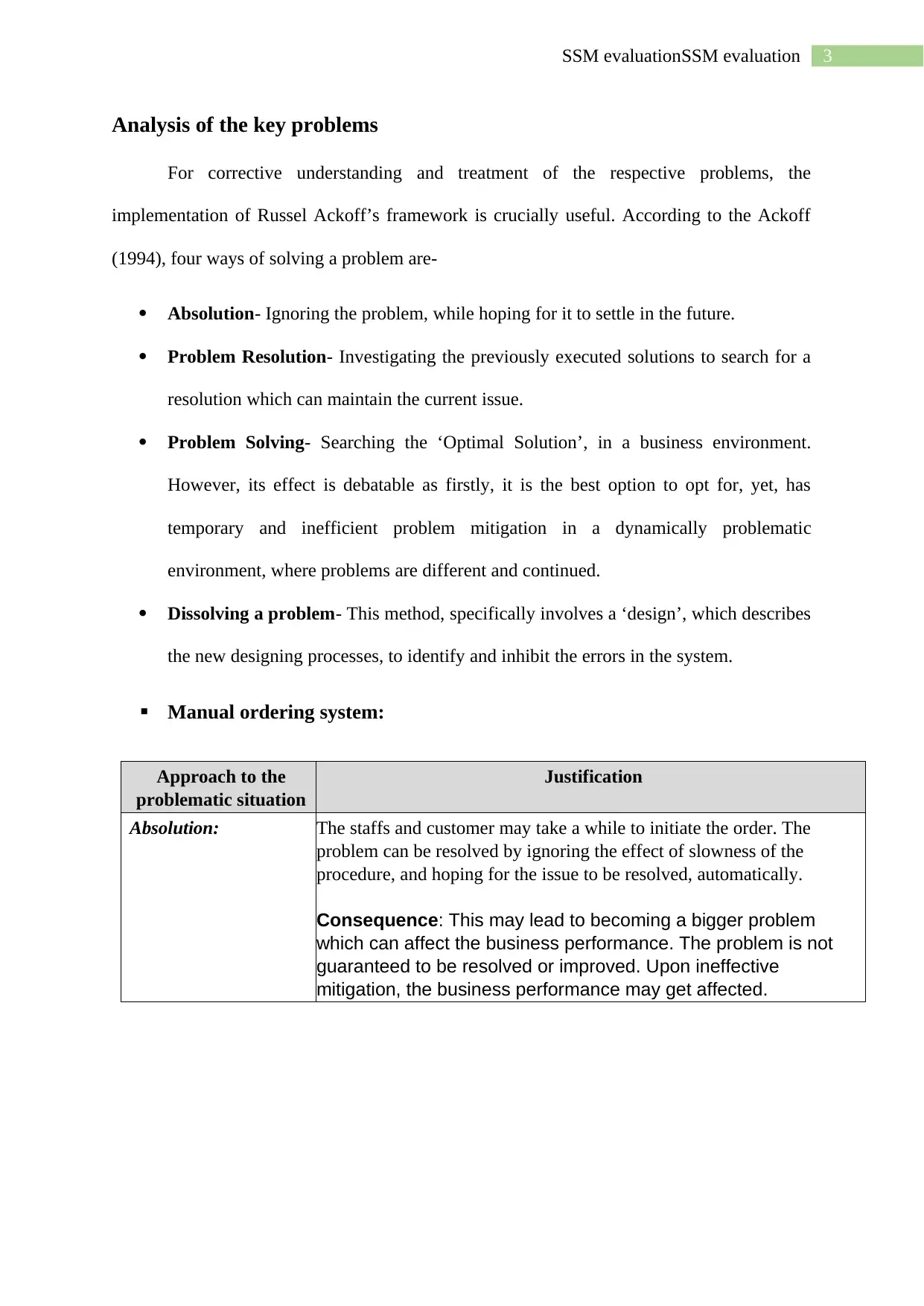
3SSM evaluationSSM evaluation
Analysis of the key problems
For corrective understanding and treatment of the respective problems, the
implementation of Russel Ackoff’s framework is crucially useful. According to the Ackoff
(1994), four ways of solving a problem are-
Absolution- Ignoring the problem, while hoping for it to settle in the future.
Problem Resolution- Investigating the previously executed solutions to search for a
resolution which can maintain the current issue.
Problem Solving- Searching the ‘Optimal Solution’, in a business environment.
However, its effect is debatable as firstly, it is the best option to opt for, yet, has
temporary and inefficient problem mitigation in a dynamically problematic
environment, where problems are different and continued.
Dissolving a problem- This method, specifically involves a ‘design’, which describes
the new designing processes, to identify and inhibit the errors in the system.
Manual ordering system:
Approach to the
problematic situation
Justification
Absolution: The staffs and customer may take a while to initiate the order. The
problem can be resolved by ignoring the effect of slowness of the
procedure, and hoping for the issue to be resolved, automatically.
Consequence: This may lead to becoming a bigger problem
which can affect the business performance. The problem is not
guaranteed to be resolved or improved. Upon ineffective
mitigation, the business performance may get affected.
Analysis of the key problems
For corrective understanding and treatment of the respective problems, the
implementation of Russel Ackoff’s framework is crucially useful. According to the Ackoff
(1994), four ways of solving a problem are-
Absolution- Ignoring the problem, while hoping for it to settle in the future.
Problem Resolution- Investigating the previously executed solutions to search for a
resolution which can maintain the current issue.
Problem Solving- Searching the ‘Optimal Solution’, in a business environment.
However, its effect is debatable as firstly, it is the best option to opt for, yet, has
temporary and inefficient problem mitigation in a dynamically problematic
environment, where problems are different and continued.
Dissolving a problem- This method, specifically involves a ‘design’, which describes
the new designing processes, to identify and inhibit the errors in the system.
Manual ordering system:
Approach to the
problematic situation
Justification
Absolution: The staffs and customer may take a while to initiate the order. The
problem can be resolved by ignoring the effect of slowness of the
procedure, and hoping for the issue to be resolved, automatically.
Consequence: This may lead to becoming a bigger problem
which can affect the business performance. The problem is not
guaranteed to be resolved or improved. Upon ineffective
mitigation, the business performance may get affected.
Paraphrase This Document
Need a fresh take? Get an instant paraphrase of this document with our AI Paraphraser
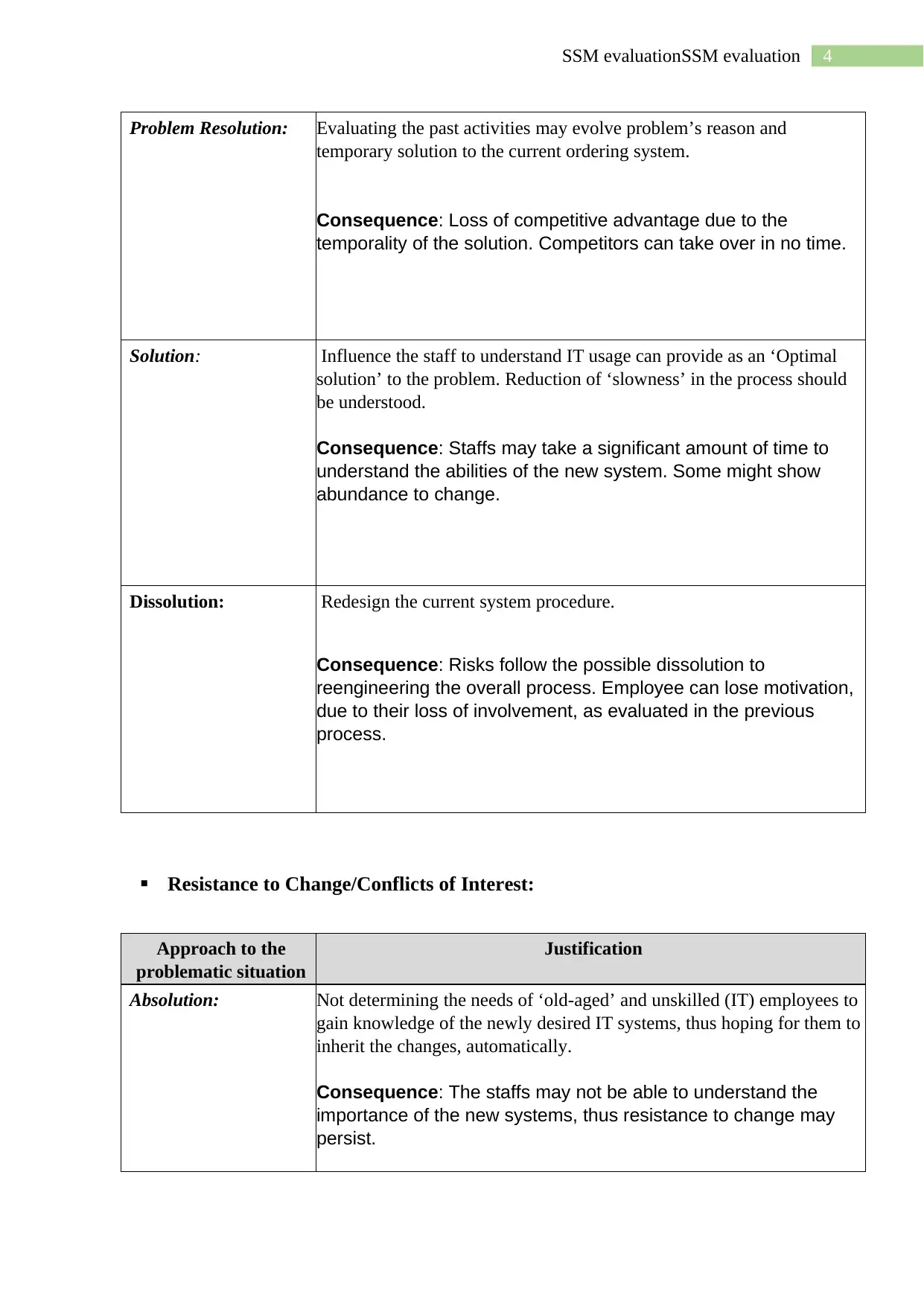
4SSM evaluationSSM evaluation
Problem Resolution: Evaluating the past activities may evolve problem’s reason and
temporary solution to the current ordering system.
Consequence: Loss of competitive advantage due to the
temporality of the solution. Competitors can take over in no time.
Solution: Influence the staff to understand IT usage can provide as an ‘Optimal
solution’ to the problem. Reduction of ‘slowness’ in the process should
be understood.
Consequence: Staffs may take a significant amount of time to
understand the abilities of the new system. Some might show
abundance to change.
Dissolution: Redesign the current system procedure.
Consequence: Risks follow the possible dissolution to
reengineering the overall process. Employee can lose motivation,
due to their loss of involvement, as evaluated in the previous
process.
Resistance to Change/Conflicts of Interest:
Approach to the
problematic situation
Justification
Absolution: Not determining the needs of ‘old-aged’ and unskilled (IT) employees to
gain knowledge of the newly desired IT systems, thus hoping for them to
inherit the changes, automatically.
Consequence: The staffs may not be able to understand the
importance of the new systems, thus resistance to change may
persist.
Problem Resolution: Evaluating the past activities may evolve problem’s reason and
temporary solution to the current ordering system.
Consequence: Loss of competitive advantage due to the
temporality of the solution. Competitors can take over in no time.
Solution: Influence the staff to understand IT usage can provide as an ‘Optimal
solution’ to the problem. Reduction of ‘slowness’ in the process should
be understood.
Consequence: Staffs may take a significant amount of time to
understand the abilities of the new system. Some might show
abundance to change.
Dissolution: Redesign the current system procedure.
Consequence: Risks follow the possible dissolution to
reengineering the overall process. Employee can lose motivation,
due to their loss of involvement, as evaluated in the previous
process.
Resistance to Change/Conflicts of Interest:
Approach to the
problematic situation
Justification
Absolution: Not determining the needs of ‘old-aged’ and unskilled (IT) employees to
gain knowledge of the newly desired IT systems, thus hoping for them to
inherit the changes, automatically.
Consequence: The staffs may not be able to understand the
importance of the new systems, thus resistance to change may
persist.
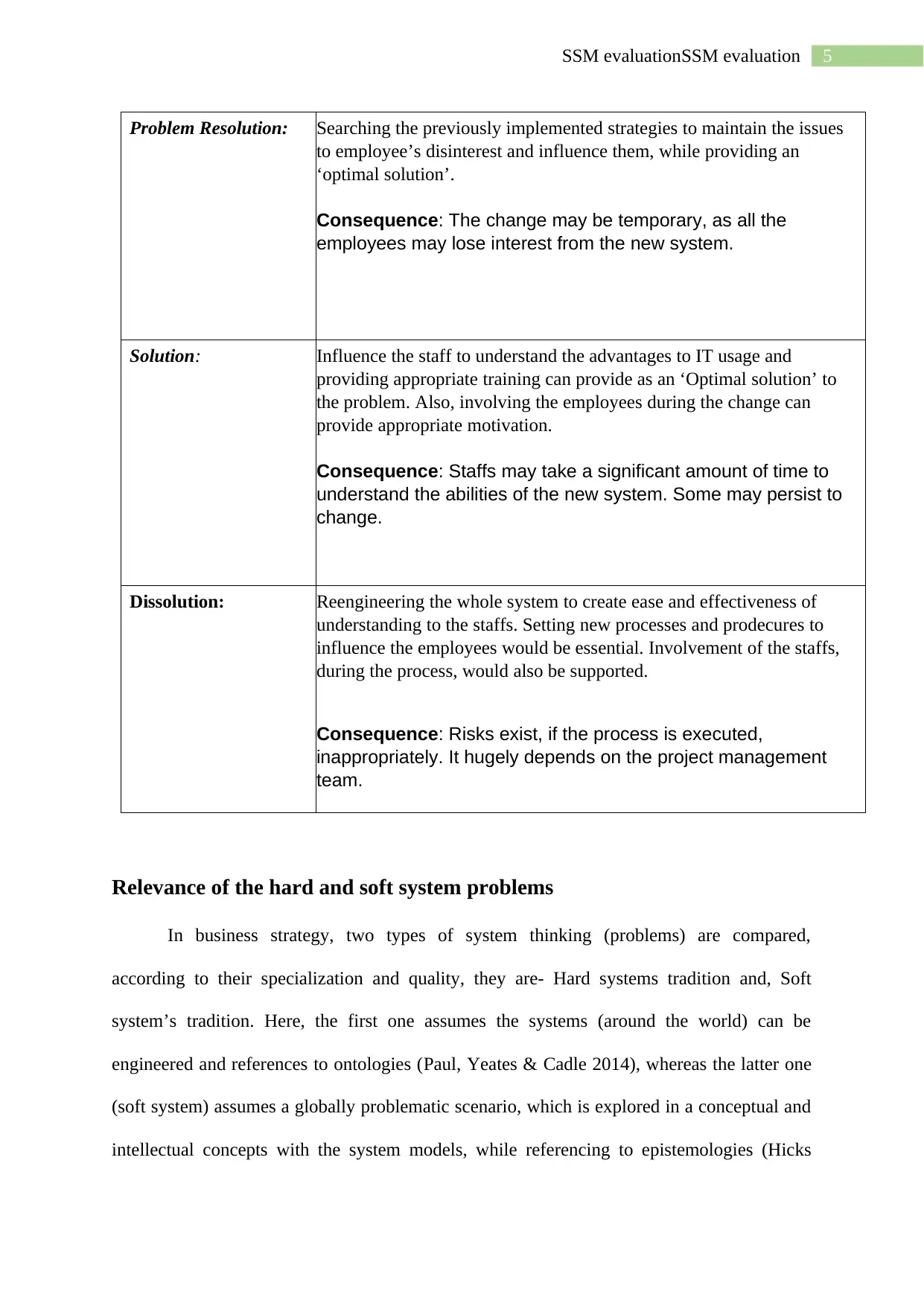
5SSM evaluationSSM evaluation
Problem Resolution: Searching the previously implemented strategies to maintain the issues
to employee’s disinterest and influence them, while providing an
‘optimal solution’.
Consequence: The change may be temporary, as all the
employees may lose interest from the new system.
Solution: Influence the staff to understand the advantages to IT usage and
providing appropriate training can provide as an ‘Optimal solution’ to
the problem. Also, involving the employees during the change can
provide appropriate motivation.
Consequence: Staffs may take a significant amount of time to
understand the abilities of the new system. Some may persist to
change.
Dissolution: Reengineering the whole system to create ease and effectiveness of
understanding to the staffs. Setting new processes and prodecures to
influence the employees would be essential. Involvement of the staffs,
during the process, would also be supported.
Consequence: Risks exist, if the process is executed,
inappropriately. It hugely depends on the project management
team.
Relevance of the hard and soft system problems
In business strategy, two types of system thinking (problems) are compared,
according to their specialization and quality, they are- Hard systems tradition and, Soft
system’s tradition. Here, the first one assumes the systems (around the world) can be
engineered and references to ontologies (Paul, Yeates & Cadle 2014), whereas the latter one
(soft system) assumes a globally problematic scenario, which is explored in a conceptual and
intellectual concepts with the system models, while referencing to epistemologies (Hicks
Problem Resolution: Searching the previously implemented strategies to maintain the issues
to employee’s disinterest and influence them, while providing an
‘optimal solution’.
Consequence: The change may be temporary, as all the
employees may lose interest from the new system.
Solution: Influence the staff to understand the advantages to IT usage and
providing appropriate training can provide as an ‘Optimal solution’ to
the problem. Also, involving the employees during the change can
provide appropriate motivation.
Consequence: Staffs may take a significant amount of time to
understand the abilities of the new system. Some may persist to
change.
Dissolution: Reengineering the whole system to create ease and effectiveness of
understanding to the staffs. Setting new processes and prodecures to
influence the employees would be essential. Involvement of the staffs,
during the process, would also be supported.
Consequence: Risks exist, if the process is executed,
inappropriately. It hugely depends on the project management
team.
Relevance of the hard and soft system problems
In business strategy, two types of system thinking (problems) are compared,
according to their specialization and quality, they are- Hard systems tradition and, Soft
system’s tradition. Here, the first one assumes the systems (around the world) can be
engineered and references to ontologies (Paul, Yeates & Cadle 2014), whereas the latter one
(soft system) assumes a globally problematic scenario, which is explored in a conceptual and
intellectual concepts with the system models, while referencing to epistemologies (Hicks
⊘ This is a preview!⊘
Do you want full access?
Subscribe today to unlock all pages.

Trusted by 1+ million students worldwide
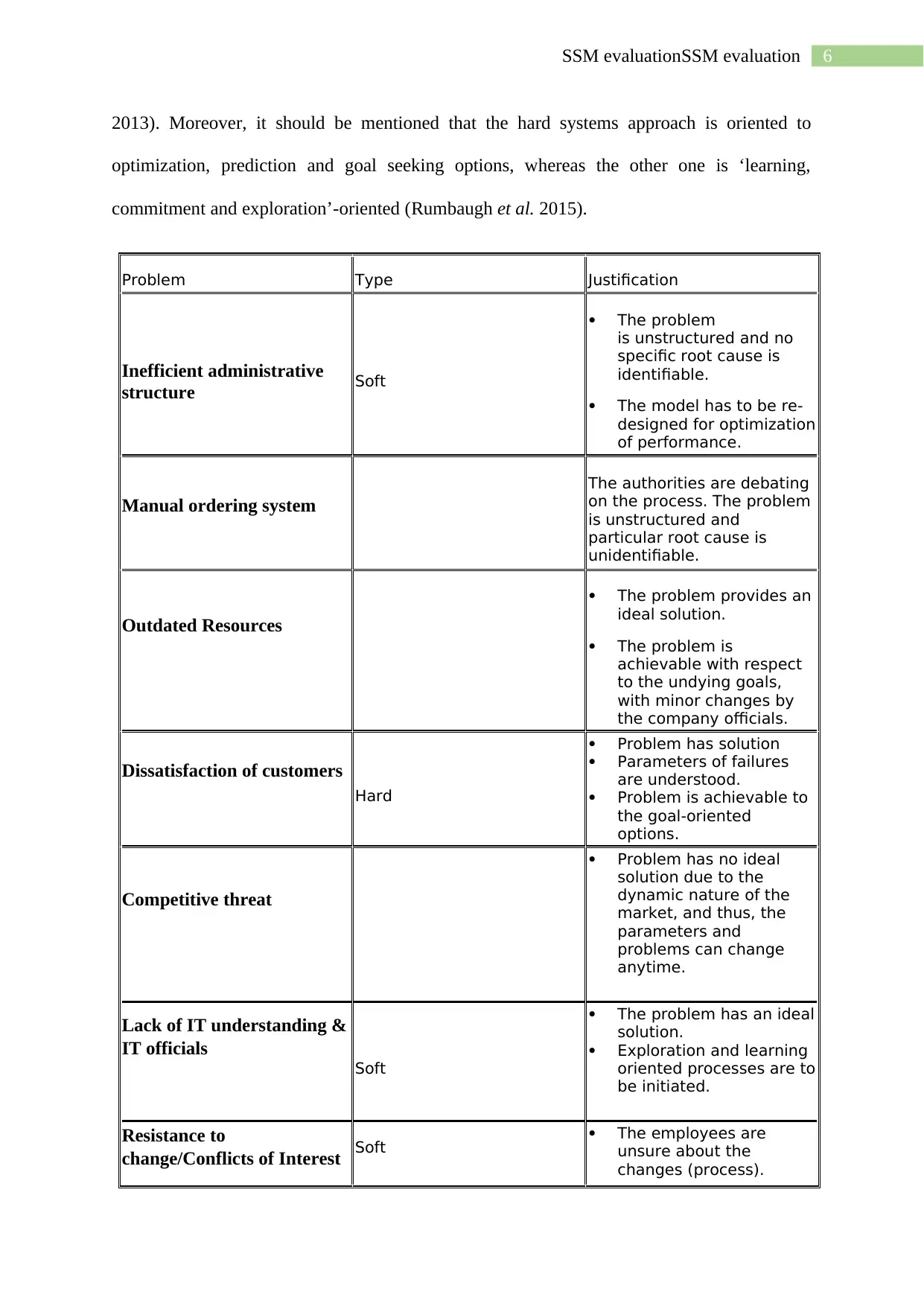
6SSM evaluationSSM evaluation
2013). Moreover, it should be mentioned that the hard systems approach is oriented to
optimization, prediction and goal seeking options, whereas the other one is ‘learning,
commitment and exploration’-oriented (Rumbaugh et al. 2015).
Problem Type Justification
Inefficient administrative
structure Soft
The problem
is unstructured and no
specific root cause is
identifiable.
The model has to be re-
designed for optimization
of performance.
Manual ordering system
The authorities are debating
on the process. The problem
is unstructured and
particular root cause is
unidentifiable.
Outdated Resources
The problem provides an
ideal solution.
The problem is
achievable with respect
to the undying goals,
with minor changes by
the company officials.
Dissatisfaction of customers
Hard
Problem has solution
Parameters of failures
are understood.
Problem is achievable to
the goal-oriented
options.
Competitive threat
Problem has no ideal
solution due to the
dynamic nature of the
market, and thus, the
parameters and
problems can change
anytime.
Lack of IT understanding &
IT officials
Soft
The problem has an ideal
solution.
Exploration and learning
oriented processes are to
be initiated.
Resistance to
change/Conflicts of Interest Soft The employees are
unsure about the
changes (process).
2013). Moreover, it should be mentioned that the hard systems approach is oriented to
optimization, prediction and goal seeking options, whereas the other one is ‘learning,
commitment and exploration’-oriented (Rumbaugh et al. 2015).
Problem Type Justification
Inefficient administrative
structure Soft
The problem
is unstructured and no
specific root cause is
identifiable.
The model has to be re-
designed for optimization
of performance.
Manual ordering system
The authorities are debating
on the process. The problem
is unstructured and
particular root cause is
unidentifiable.
Outdated Resources
The problem provides an
ideal solution.
The problem is
achievable with respect
to the undying goals,
with minor changes by
the company officials.
Dissatisfaction of customers
Hard
Problem has solution
Parameters of failures
are understood.
Problem is achievable to
the goal-oriented
options.
Competitive threat
Problem has no ideal
solution due to the
dynamic nature of the
market, and thus, the
parameters and
problems can change
anytime.
Lack of IT understanding &
IT officials
Soft
The problem has an ideal
solution.
Exploration and learning
oriented processes are to
be initiated.
Resistance to
change/Conflicts of Interest Soft The employees are
unsure about the
changes (process).
Paraphrase This Document
Need a fresh take? Get an instant paraphrase of this document with our AI Paraphraser
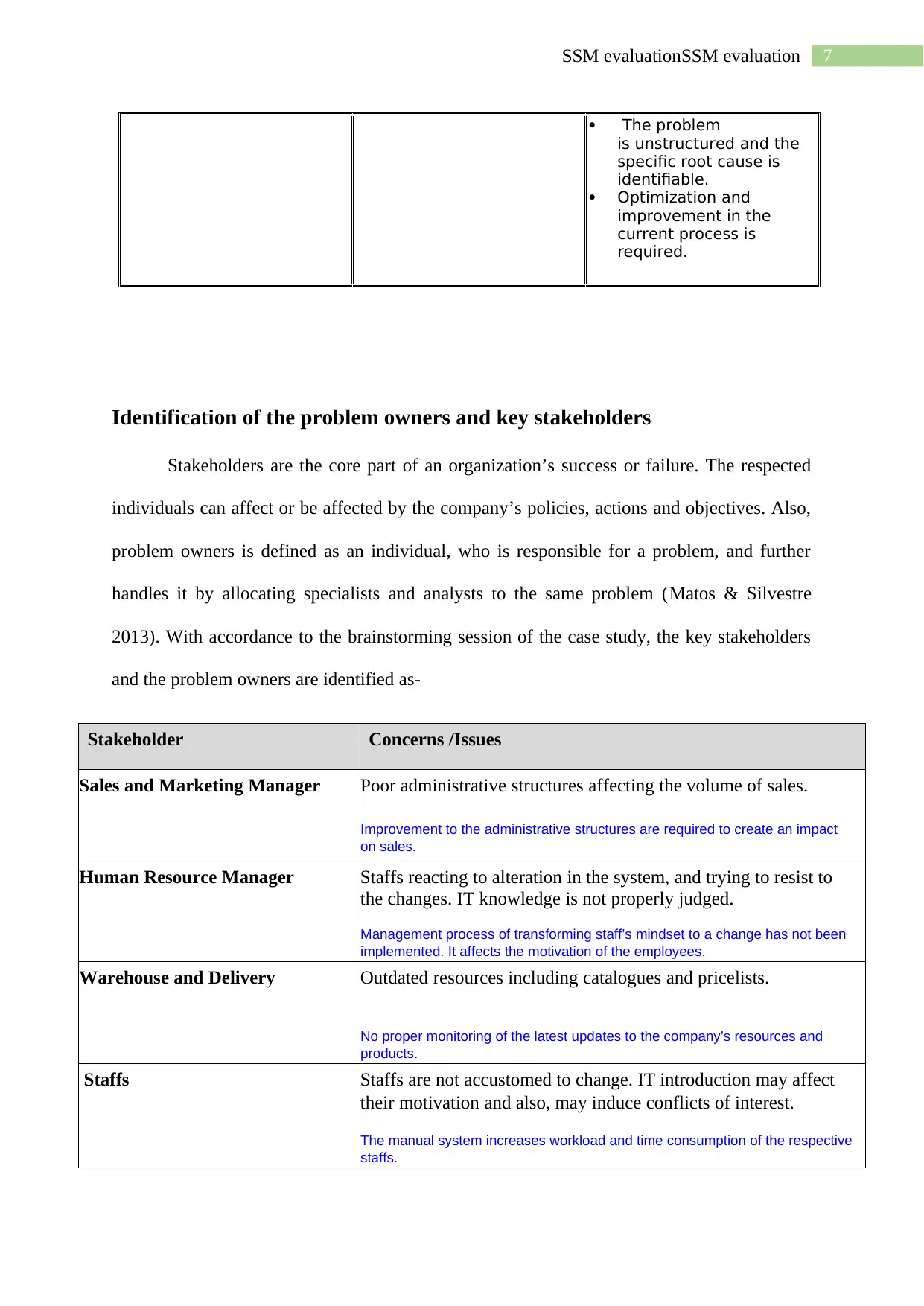
7SSM evaluationSSM evaluation
The problem
is unstructured and the
specific root cause is
identifiable.
Optimization and
improvement in the
current process is
required.
Identification of the problem owners and key stakeholders
Stakeholders are the core part of an organization’s success or failure. The respected
individuals can affect or be affected by the company’s policies, actions and objectives. Also,
problem owners is defined as an individual, who is responsible for a problem, and further
handles it by allocating specialists and analysts to the same problem (Matos & Silvestre
2013). With accordance to the brainstorming session of the case study, the key stakeholders
and the problem owners are identified as-
Stakeholder Concerns /Issues
Sales and Marketing Manager Poor administrative structures affecting the volume of sales.
Improvement to the administrative structures are required to create an impact
on sales.
Human Resource Manager Staffs reacting to alteration in the system, and trying to resist to
the changes. IT knowledge is not properly judged.
Management process of transforming staff’s mindset to a change has not been
implemented. It affects the motivation of the employees.
Warehouse and Delivery Outdated resources including catalogues and pricelists.
No proper monitoring of the latest updates to the company’s resources and
products.
Staffs Staffs are not accustomed to change. IT introduction may affect
their motivation and also, may induce conflicts of interest.
The manual system increases workload and time consumption of the respective
staffs.
The problem
is unstructured and the
specific root cause is
identifiable.
Optimization and
improvement in the
current process is
required.
Identification of the problem owners and key stakeholders
Stakeholders are the core part of an organization’s success or failure. The respected
individuals can affect or be affected by the company’s policies, actions and objectives. Also,
problem owners is defined as an individual, who is responsible for a problem, and further
handles it by allocating specialists and analysts to the same problem (Matos & Silvestre
2013). With accordance to the brainstorming session of the case study, the key stakeholders
and the problem owners are identified as-
Stakeholder Concerns /Issues
Sales and Marketing Manager Poor administrative structures affecting the volume of sales.
Improvement to the administrative structures are required to create an impact
on sales.
Human Resource Manager Staffs reacting to alteration in the system, and trying to resist to
the changes. IT knowledge is not properly judged.
Management process of transforming staff’s mindset to a change has not been
implemented. It affects the motivation of the employees.
Warehouse and Delivery Outdated resources including catalogues and pricelists.
No proper monitoring of the latest updates to the company’s resources and
products.
Staffs Staffs are not accustomed to change. IT introduction may affect
their motivation and also, may induce conflicts of interest.
The manual system increases workload and time consumption of the respective
staffs.
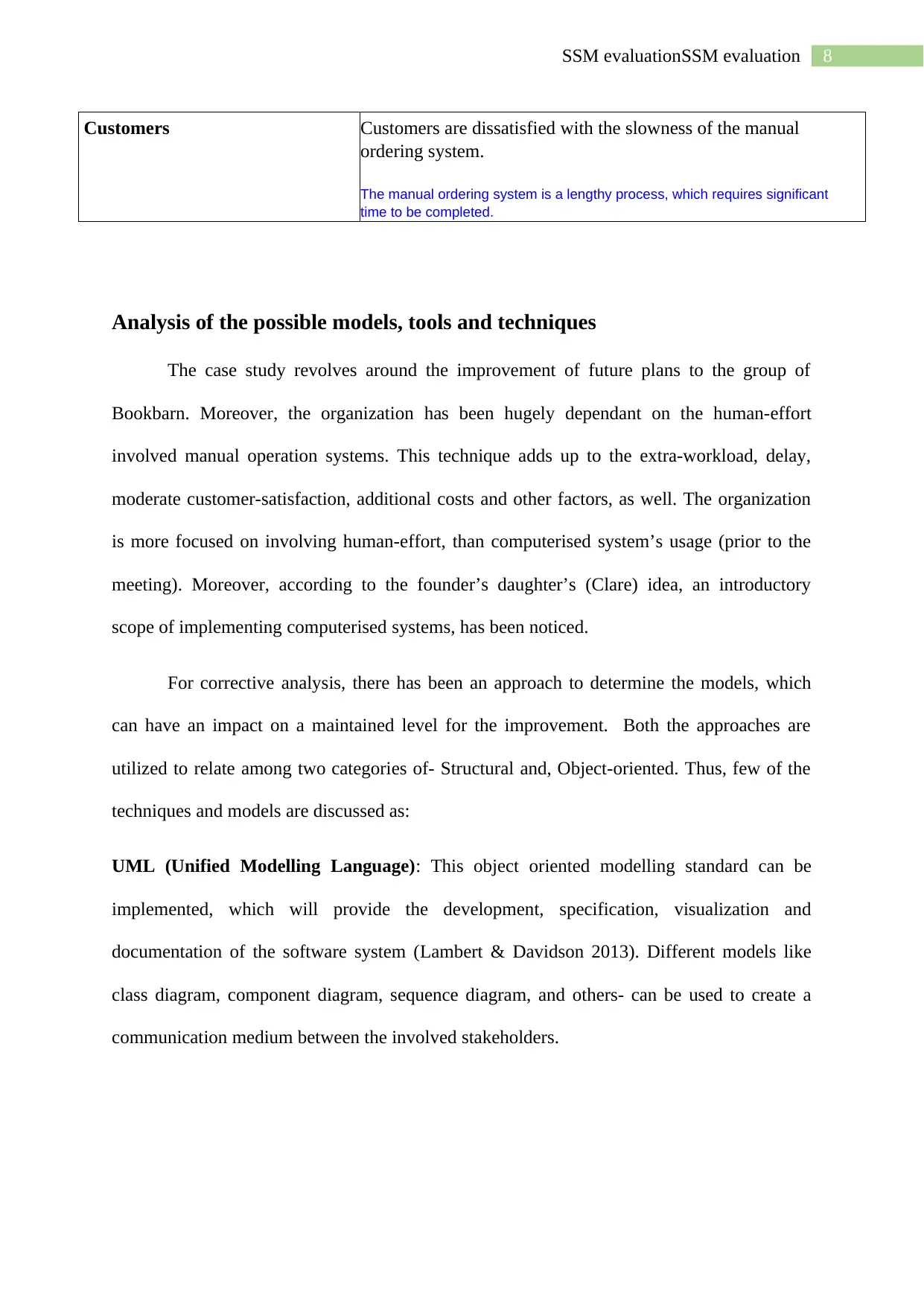
8SSM evaluationSSM evaluation
Customers Customers are dissatisfied with the slowness of the manual
ordering system.
The manual ordering system is a lengthy process, which requires significant
time to be completed.
Analysis of the possible models, tools and techniques
The case study revolves around the improvement of future plans to the group of
Bookbarn. Moreover, the organization has been hugely dependant on the human-effort
involved manual operation systems. This technique adds up to the extra-workload, delay,
moderate customer-satisfaction, additional costs and other factors, as well. The organization
is more focused on involving human-effort, than computerised system’s usage (prior to the
meeting). Moreover, according to the founder’s daughter’s (Clare) idea, an introductory
scope of implementing computerised systems, has been noticed.
For corrective analysis, there has been an approach to determine the models, which
can have an impact on a maintained level for the improvement. Both the approaches are
utilized to relate among two categories of- Structural and, Object-oriented. Thus, few of the
techniques and models are discussed as:
UML (Unified Modelling Language): This object oriented modelling standard can be
implemented, which will provide the development, specification, visualization and
documentation of the software system (Lambert & Davidson 2013). Different models like
class diagram, component diagram, sequence diagram, and others- can be used to create a
communication medium between the involved stakeholders.
Customers Customers are dissatisfied with the slowness of the manual
ordering system.
The manual ordering system is a lengthy process, which requires significant
time to be completed.
Analysis of the possible models, tools and techniques
The case study revolves around the improvement of future plans to the group of
Bookbarn. Moreover, the organization has been hugely dependant on the human-effort
involved manual operation systems. This technique adds up to the extra-workload, delay,
moderate customer-satisfaction, additional costs and other factors, as well. The organization
is more focused on involving human-effort, than computerised system’s usage (prior to the
meeting). Moreover, according to the founder’s daughter’s (Clare) idea, an introductory
scope of implementing computerised systems, has been noticed.
For corrective analysis, there has been an approach to determine the models, which
can have an impact on a maintained level for the improvement. Both the approaches are
utilized to relate among two categories of- Structural and, Object-oriented. Thus, few of the
techniques and models are discussed as:
UML (Unified Modelling Language): This object oriented modelling standard can be
implemented, which will provide the development, specification, visualization and
documentation of the software system (Lambert & Davidson 2013). Different models like
class diagram, component diagram, sequence diagram, and others- can be used to create a
communication medium between the involved stakeholders.
⊘ This is a preview!⊘
Do you want full access?
Subscribe today to unlock all pages.

Trusted by 1+ million students worldwide
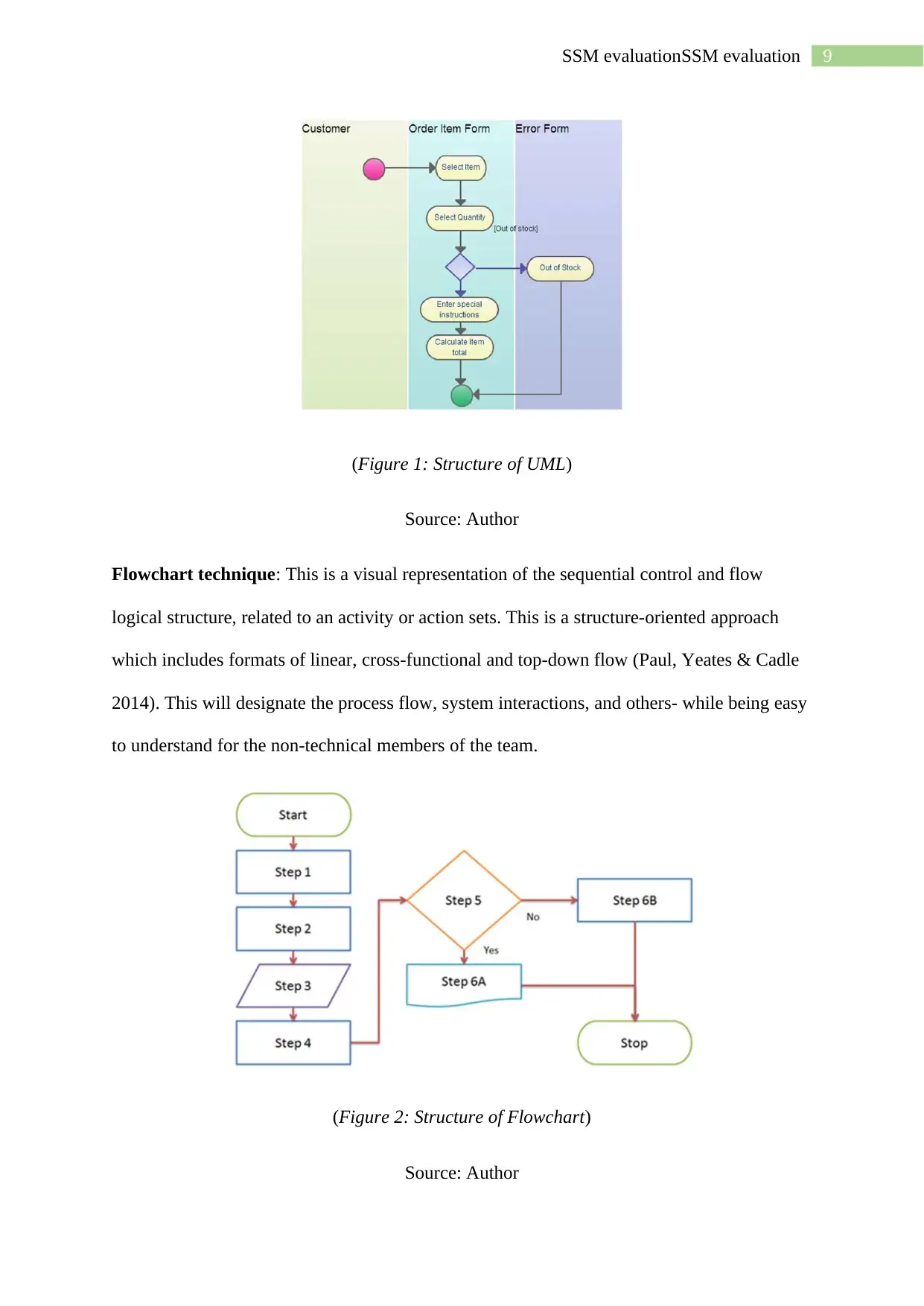
9SSM evaluationSSM evaluation
(Figure 1: Structure of UML)
Source: Author
Flowchart technique: This is a visual representation of the sequential control and flow
logical structure, related to an activity or action sets. This is a structure-oriented approach
which includes formats of linear, cross-functional and top-down flow (Paul, Yeates & Cadle
2014). This will designate the process flow, system interactions, and others- while being easy
to understand for the non-technical members of the team.
(Figure 2: Structure of Flowchart)
Source: Author
(Figure 1: Structure of UML)
Source: Author
Flowchart technique: This is a visual representation of the sequential control and flow
logical structure, related to an activity or action sets. This is a structure-oriented approach
which includes formats of linear, cross-functional and top-down flow (Paul, Yeates & Cadle
2014). This will designate the process flow, system interactions, and others- while being easy
to understand for the non-technical members of the team.
(Figure 2: Structure of Flowchart)
Source: Author
Paraphrase This Document
Need a fresh take? Get an instant paraphrase of this document with our AI Paraphraser
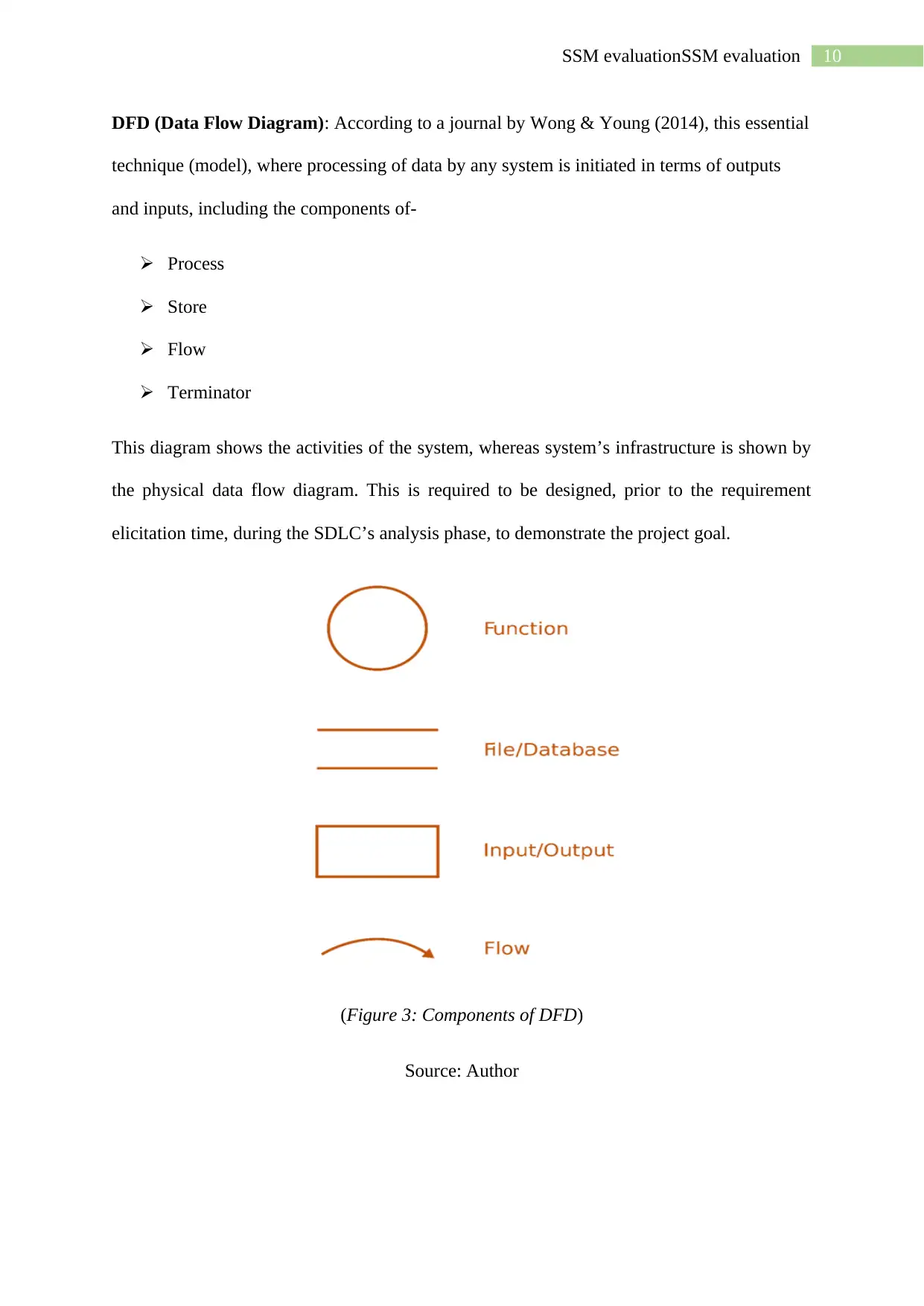
10SSM evaluationSSM evaluation
DFD (Data Flow Diagram): According to a journal by Wong & Young (2014), this essential
technique (model), where processing of data by any system is initiated in terms of outputs
and inputs, including the components of-
Process
Store
Flow
Terminator
This diagram shows the activities of the system, whereas system’s infrastructure is shown by
the physical data flow diagram. This is required to be designed, prior to the requirement
elicitation time, during the SDLC’s analysis phase, to demonstrate the project goal.
(Figure 3: Components of DFD)
Source: Author
DFD (Data Flow Diagram): According to a journal by Wong & Young (2014), this essential
technique (model), where processing of data by any system is initiated in terms of outputs
and inputs, including the components of-
Process
Store
Flow
Terminator
This diagram shows the activities of the system, whereas system’s infrastructure is shown by
the physical data flow diagram. This is required to be designed, prior to the requirement
elicitation time, during the SDLC’s analysis phase, to demonstrate the project goal.
(Figure 3: Components of DFD)
Source: Author
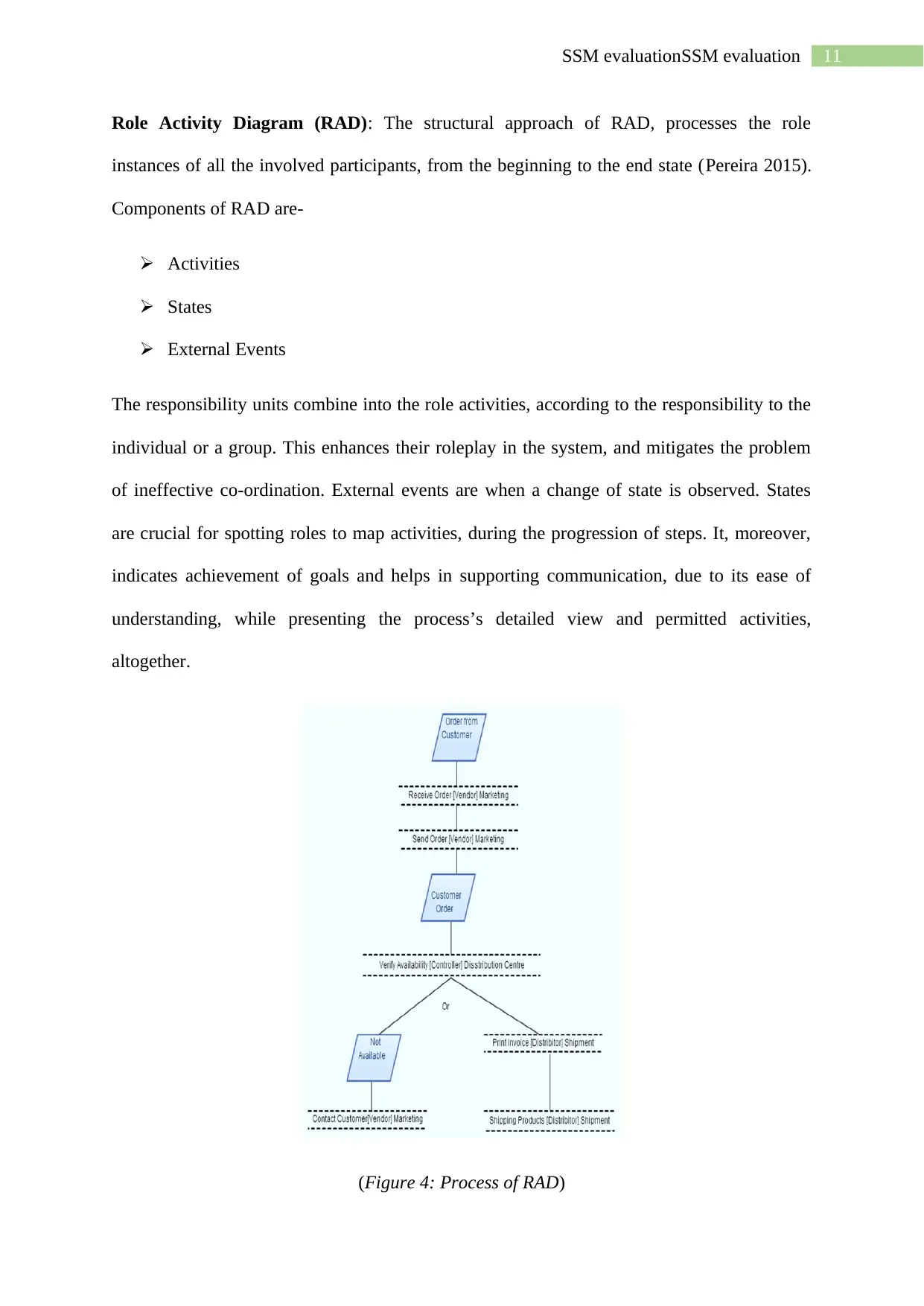
11SSM evaluationSSM evaluation
Role Activity Diagram (RAD): The structural approach of RAD, processes the role
instances of all the involved participants, from the beginning to the end state (Pereira 2015).
Components of RAD are-
Activities
States
External Events
The responsibility units combine into the role activities, according to the responsibility to the
individual or a group. This enhances their roleplay in the system, and mitigates the problem
of ineffective co-ordination. External events are when a change of state is observed. States
are crucial for spotting roles to map activities, during the progression of steps. It, moreover,
indicates achievement of goals and helps in supporting communication, due to its ease of
understanding, while presenting the process’s detailed view and permitted activities,
altogether.
(Figure 4: Process of RAD)
Role Activity Diagram (RAD): The structural approach of RAD, processes the role
instances of all the involved participants, from the beginning to the end state (Pereira 2015).
Components of RAD are-
Activities
States
External Events
The responsibility units combine into the role activities, according to the responsibility to the
individual or a group. This enhances their roleplay in the system, and mitigates the problem
of ineffective co-ordination. External events are when a change of state is observed. States
are crucial for spotting roles to map activities, during the progression of steps. It, moreover,
indicates achievement of goals and helps in supporting communication, due to its ease of
understanding, while presenting the process’s detailed view and permitted activities,
altogether.
(Figure 4: Process of RAD)
⊘ This is a preview!⊘
Do you want full access?
Subscribe today to unlock all pages.

Trusted by 1+ million students worldwide
1 out of 18
Related Documents
Your All-in-One AI-Powered Toolkit for Academic Success.
+13062052269
info@desklib.com
Available 24*7 on WhatsApp / Email
![[object Object]](/_next/static/media/star-bottom.7253800d.svg)
Unlock your academic potential
Copyright © 2020–2025 A2Z Services. All Rights Reserved. Developed and managed by ZUCOL.





